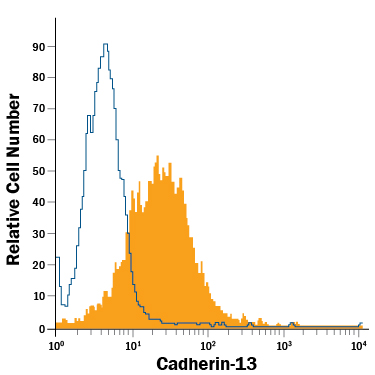Human Cadherin-13 PE-conjugated Antibody Summary
Glu23-Ala692
Accession # P55290
Applications
Please Note: Optimal dilutions should be determined by each laboratory for each application. General Protocols are available in the Technical Information section on our website.
Scientific Data
 View Larger
View Larger
Detection of Cadherin‑13 in NCI‑H460 Human Cell Line by Flow Cytometry. NCI-H460 human large cell lung carcinoma cell line was stained with Rat Anti-Human Cadherin-13 PE-conjugated Monoclonal Antibody (Catalog # FAB3264P, filled histogram) or isotype control antibody (Catalog # IC006P, open histogram). View our protocol for Staining Membrane-associated Proteins.
Reconstitution Calculator
Preparation and Storage
Background: Cadherin-13
Cadherin-13, also known as T-cadherin and H-cadherin, is a 105 kDa member of the cadherin family of transmembrane glycoproteins that mediate calcium-dependent intercellular adhesion (1). However, Cadherin-13 is an atypical member, lacking transmembrane and cytosolic domains and containing a GPI moiety that anchors Cadherin-13 to the plasma membrane (1‑2). Human Cadherin-13 is synthesized as a 713 amino acid (aa) precursor that contains a 22 aa signal sequence, a 116 aa propeptide, a 555 aa mature chain, and a second propeptide of 20 aa that is removed in the mature form to reveal the GPI anchor. The mature form contains five cadherin domains and eight potential sites for N-linked glycosylation. Mature human Cadherin-13 shares 96% aa identity with mature mouse Cadherin-13. Cadherin-13 is expressed in various tissues. It is highly expressed in the heart, and in the CNS, Cadherin-13 is expressed in the cerebral cortex, medulla, hippocampus, amygdala, thalamus, and substantia nigra (2). There are higher levels of Cadherin-13 in the adult brain than in developing brain (2). Cadherin-13 is also expressed in skin in the basal layer of the epidermis, lung, liver, kidney, and blood vessels (2). The structural characteristics of Cadherin-13 predict that it is unlikely to function as a true adhesion molecule in vivo (2). It is suggested that it may act rather as a signaling receptor participating in recognition of the environment and regulation of cell motility, proliferation, and phenotype (2). Cellular expression levels of Cadherin-13 in various tissues often correlate, negatively or positively, with the proliferative potential of the cells (2). Cadherin-13 may also act as a suppressor of tumor cell growth (2). This potential role for Cadherin-13 was emphasized by localization of Cadherin-13 gene to chromosome 16q24, a region exhibiting loss of heterozygosity in many solid tumors (2). Allelic loss of chromosome bands 16q24.1-q24.2 and reduced expression of Cadherin-13, as well as hypermethylation of the remaining allele have been detected in a considerable number of human cancers (2).
- Tanihara, H. et al. (1994) Cell Adhes. Commun. 2:15.
- Philippova, M. et al. (2009) Cell. Signal. 21:1035.
Product Datasheets
FAQs
No product specific FAQs exist for this product, however you may
View all Antibody FAQsReviews for Human Cadherin-13 PE-conjugated Antibody
There are currently no reviews for this product. Be the first to review Human Cadherin-13 PE-conjugated Antibody and earn rewards!
Have you used Human Cadherin-13 PE-conjugated Antibody?
Submit a review and receive an Amazon gift card.
$25/€18/£15/$25CAN/¥75 Yuan/¥2500 Yen for a review with an image
$10/€7/£6/$10 CAD/¥70 Yuan/¥1110 Yen for a review without an image

